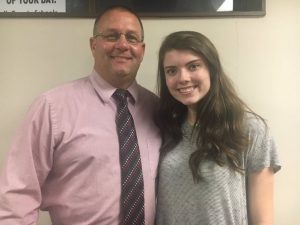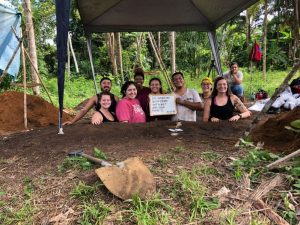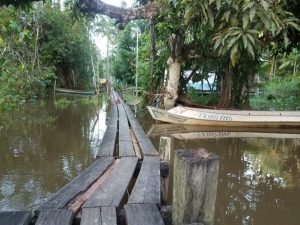News
DCHS Senior Madi Cantrell Named Semifinalist for National Merit Scholarship Program
September 13, 2018
By: Dwayne Page
A DeKalb County High School senior has qualified as a Semifinalist for the National Merit Scholarship Program.
Madison Elizabeth (Madi) Cantrell, daughter of Todd and Jenny Cantrell, has been named among 16,000 Semifinalists nationwide for this honor. The National Merit® Scholarship Program awards individual students who show exceptional academic ability and potential for success in rigorous college studies.
Cantrell has been identified among these academically talented high school seniors who have an opportunity to continue in the competition for some 7,500 National Merit Scholarships worth more than $31 million that will be offered next spring. To be considered for a Merit Scholarship® award, Semifinalists must fulfill several requirements to advance to the Finalist level of the competition. Over 90 percent of the Semifinalists are expected to attain Finalist standing, and about half of the Finalists will win a National Merit Scholarship, earning the Merit Scholar® title.
“We are very, very proud of Madison. This is my 17th year here at DCHS and this is only the second student we have had during that time to qualify as a semifinalist,” said Lori Myrick, Guidance Counselor at DCHS.
Principal Randy Jennings informed Director of Schools Patrick Cripps and the Board of Education of this honor for Madison during Thursday night’s regular monthly school board meeting. He also introduced Madison who was seated in the audience.
NMSC, a not-for-profit organization that operates without government assistance, was established in 1955 specifically to conduct the annual National Merit Scholarship Program. Scholarships are underwritten by NMSC with its own funds and by approximately 410 business organizations and higher education institutions that share NMSC’s goals of honoring the nation’s scholastic champions and encouraging the pursuit of academic excellence.
Over 1.6 million juniors in about 22,000 high schools entered the 2019 National Merit Scholarship Program by taking the 2017 Preliminary SAT/National Merit Scholarship Qualifying Test (PSAT/NMSQT®), which served as an initial screen of program entrants. The nationwide pool of Semifinalists, representing less than one percent of U.S. high school seniors, includes the highest scoring entrants in each state. To become a Finalist, the Semifinalist and his or her high school must submit a detailed scholarship application, in which they provide information about the Semifinalist’s academic record, participation in school and community activities, demonstrated leadership abilities, employment, and honors and awards received. A Semifinalist must have an outstanding academic record throughout high school, be endorsed and recommended by a high school official, write an essay, and earn SAT® scores that confirm the student’s earlier performance on the qualifying test. From the approximately 16,000 Semifinalists, about 15,000 are expected to advance to the Finalist level, and in February they will be notified of this designation. All National Merit Scholarship winners will be selected from this group of Finalists. Merit Scholar designees are selected on the basis of their skills, accomplishments, and potential for success in rigorous college studies, without regard to gender, race, ethnic origin, or religious preference.
DeKalb County’s Indiana Jones Explores South America
September 13, 2018
By: Bill Conger
DeKalb County has its own version of the famous Indiana Jones movie character. 19-year-old Bailey Redmon, a 2017 D.C.H.S. graduate, flew to Gurupa Miri, Brazil this summer for a history-marking archeology expedition.
Along with a team of M.T.S.U. students, the History major dug a 2 meter by 1 meter unit, looking for relics
“We got about 60 centimeters down where it was too deep to reach into, so we had to actually get into it,” Redmon recalls. “One of the girls that I was working with took off her shoes and got in. As soon as she got in, the corner of it collapsed.”
That turned out to be a fortuitous event that revealed an empty ant colony filled with ceramics and vases. It was basically a past generation’s dumping spot that archeologists call trash midden.
“We found shards that were decorated,” Redmon explained. “We think just by the style of the decoration that they were a prehistoric age. We found a couple of pieces of animal bone. Where we dug was an actual mound. There they look for mounds because there’s this soil formation called Terra preta, a type of very dark, fertile anthropogenic soil found in the Amazon Basin. It’s only made by the slash-and-burn agriculture that they do down in South America.”
“There would be like what we call a trash midden in archeology where they dump all their trash. Anything they wanted to discard they would burn it. That’s what we were finding. No human remains. If we found human remains, we more than likely had to have shut down the unit because the people in the community are very sensitive about that. They believe if we mess with any kind of human remains and take them away from where they were buried, then somebody in the community would get sick or they’ll die. It’s just bad luck.”
Getting permission to excavate in the area took years of relationship building in the community.
“We didn’t know if we were going to find anything, but the whole reason they chose to dig there was because archeology had never been performed there,” Redmon said. “Not that they didn’t care about their heritage, but it never really occurred to the people there could be more underneath the surface of where they lived. They were curious.”
“We were making history just by digging there, not necessarily what we were finding, because there never had really been any excavations there but in the past couple of years. I didn’t know that until we got there. We thought it had been a working site for years. “No, it’s only been two years.” So, it was like chill bumps. This is crazy,” she said, laughing.
The Archeology and Medieval Studies minor spent a month in the Portuguese-speaking nation.
“The people treated us like family even though they couldn’t communicate with us. There was this one family. The woman’s name was Doña Arlete We would go down to her house every night after we got done excavating. She would feed us all these sorts of fruits and foods that we hadn’t tried before. She treated us like we were her daughters.”
“She lived right on the Amazon River, so we would swim in the Amazon. The current was really strong, but it was muddy. You couldn’t see. It was a narrow channel so there was a lot of vegetation, jungle vines and trees. There would be huge water lilies that would float down. You would have to dodge them as you were swimming. It was cool.
“I was afraid of the piranhas because that’s where they live, but the Brazillians were jumping in. [I thought] you’re fine. I just jumped in and took a risk. That’s something that I’m glad I did and didn’t hold back and not do it because that’s something I’ll remember for the rest of my life.”
During her two-and-a-half week adventure, she slept in a hammock in a non-air conditioned hut. Although it’s the winter season there in July, cooler than normal temperatures hovered around 85 degrees couple with 100% humidity. As she tried to snooze at night, she met a special friend hanging overhead.
“There was a tarantula that lived there. He was probably about baseball size or so not including his legs. He would come out during the night rain, and he would catch his bugs and not move a muscle. I had a bug net, so I thought worse scenario, he could just fall on me during the night, and I would have to bounce him off of my net.
I ended up having fun with it. I named him Caleb because I thought if I gave him a name, then he wouldn’t seem so intimidating to me. So, every time he would come out, I’d be like, “Hey, Caleb! He’s back’.”
Redmon also got up-close and personal with several other creepy creatures.
“We also had bats that lived with us in the hut. We had huge long centipedes that were around the floor. We had frogs in the shower. All the wildlife you could imagine we had it. Fire ants were terrible.. Underneath some of the boards [on the way to the river], there’d be a colony of ants. So, I got bit several times. I started wearing my work boots with my bathing suit down to the river. I don’t care if I look silly. I’m not getting bit.”
“We had snakes that would fall into our unit [excavation site] at night, and we would have to come and kill them. Usually, they were venomous. There were also hunter spiders that would make their little nests beside our unit. They’re the ones that burrow into the ground and when an insect walks by, they jump out and grab it and bring it back into their hole. We’d have to take a machete and shove it down the hole and tear up the hole to get the spider to come out. Then, either kill it or let it run away.”
Redmon, an M.T.S.U. Senior, hopes to earn her Master’s and PhD at York University in England after she graduates next May. One day she wants to work in historical archeology. Redmon says the obstacles she faced during her trip changed her life.
“I was not prepared for that the first couple of days, but you get used to it. Oh, it’s just a snake or oh, it’s just a tarantula. I’m not skittish around that kind of stuff anymore because of that trip. It just made me grow so much as a person other than that.
“These people … encounter the same things that we did, and they still are some of the happiest people I’ve ever met in my life. They don’t let it get to them. I try to mimic that mentality. There’s nothing you can control, so you might as well be positive about it. If that trip taught me anything, it was a positive outlook is the best thing to have, especially in a tough situation like that.”
Record Setting Tourism Numbers for DeKalb County
September 13, 2018
By:
Gov. Haslam, TN Department of Tourist Development Commissioner Kevin Triplett and Musician’s Hall of Fame Director Joe Chambers gathered to celebrate the continued success of the Tennessee tourism industry by announcing the 2017 economic impact numbers at Musician’s Hall of Fame and Museum.
Gov. Haslam and Commissioner Triplett announced Tennessee tourism’s direct domestic and international travel expenditures reached a new all-time record high of $20.7 billion in 2017, up 6.3 percent over the previous year, as reported by the U.S. Travel Association. Tourism also generated 184,300 jobs for Tennesseans, a 3.1 percent growth year over year.
DeKalb County experienced a 6.7% increase in tourism dollars for a total of $48.02 million – up from the previous year’s total of $44.99 million. Chamber Director Suzanne Williams had lots to celebrate when she heard the newest tourism numbers as well as receiving the news of a new grant to be used for a Smithville Fiddlers’ Jamboree Billboard on I-40 and the Smithville Jamboree being included in Phase 1 of the new TDTD Tennessee Music Pathways initiative. “The economic impact of tourism on DeKalb County is huge. We are so fortunate to have Center Hill Lake, Edgar Evins State Park, Appalachian Center for Craft, and our many diverse businesses that fuel our tourism revenues including our annual events such as the Smithville Fiddlers’ Jamboree and Crafts Festival, DeKalb County Fair, Off the Beaten Path Studio Tour, and other local music and art events. Our small-town charm, friendly people, and scenic beauty make DeKalb County a desirable place to live, work, play, and raise a family and all these factors keep our visitors coming back year after year,” says Williams.
“Counties, cities and rural communities work hard to make our state a premier destination, welcoming visitors from around the world,” Haslam said. “Our state’s second biggest industry continues to see outstanding growth, break visitation records, boost Tennessee’s economy and create new jobs. The Tennessee Department of Tourist Development and Tennessee Tourism Committee continue to produce record results that fuel our state’s economy.”
“The authenticity and Southern hospitality from our communities and partners gives visitors an unbeatable experience and inspires them to return,” Commissioner Kevin Triplett said.
Tennessee is among the Top 10 travel destinations in the nation for the 4th consecutive year. Tennessee is also considered a top retirement destination.
Suzanne Williams will be attending the Tennessee Hospitality & Tourism Association’s Governor’s Conference in September in Kingsport where county-by-county snapshots will be shared.
« First ‹ Previous 1 2132 2222 2230 2231 22322233 2234 2242 2332 2506 Next › Last »














